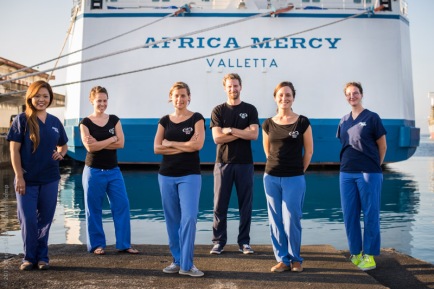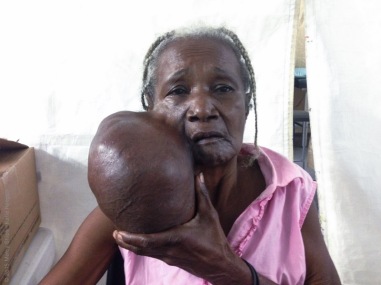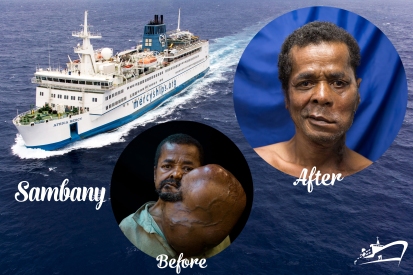The reality is sometimes we meet people that we cannot help or we
have to ask them to live with their condition a little longer. We don’t
always like it, we wish we could help every single person that came our
way on the spot, but the hard truth is there are only so many surgery
spots in a day or a surgery may require a surgeon with a particular
expertise that may not be available for a few months. It’s difficult to
explain to someone who has lived with a debilitating tumor for many
years that they have to wait a little longer or that we can’t help –
they often don’t understand, they feel like they’re going to die so why
wouldn’t we operate right now; why would we wait? Why would we say no?

The task of assessing patients, hearing their stories and
coordinating schedules thankfully falls on people gifted with a grace
and ability to juggle moving parts in a way that I am often in awe of.
Our screening team this field service has evaluated thousands of
potential patients in 11 cities throughout Madagascar. But sometimes we
don’t have to go very far to find a patient, some patients come right to
our “door step” showing up at our HOPE Center, our land-based facility
where patients heal after their surgeries, on the hope that we can help.
That’s how I met my friend Marie Helene and her sister-in-law Biviane.

About
12 years ago Marie Helene noticed a bump on the right side of her face.
She lives in a remote village but was able to have a local healer look
at it. She was given some medicinal oils that did nothing but the bump
was so small Marie Helene decided she wouldn’t worry too much about it.
However, slowly the tumor grew and over the last three years the tumor
began growing exponentially. It grew so large that it rested on Marie
Helene’s shoulder and she often had to support it with her hand. I’m
told it’s not uncommon for these types of tumors to grow very slowly at
first and all of a sudden start growing exponentially.
Marie Helene and her family didn’t know what to do. Unable to work
and help her children out in the fields, Marie Helene was looked after
quite often by her sister-in-law Biviane. The two ladies, both in their
70’s, vowed to care for one another after they both became widows just a
few months apart. They were more than sisters-in-law; they were the
best of friends.

Biviane was concerned that if Marie Helene did not receive help soon
she would soon die. For months the two ladies had listened to travelers
on their way home to the northern parts of Madagascar come through their
village. They told a strange tale of returning from a hospital ship
where they had experienced tremendous healing. People spoke of the
foreigners on the ship and how well they were cared for and how
everything provided was free. And then one day Biviane was visiting a
friend in a larger city and she saw a news story of a man named Sambany,
whose tumor was larger than Marie Helene’s and was removed. Biviane
convinced Marie Helene to make the journey as the last hope to save her
life. Marie Helene agreed and the two set off on a Saturday down the
river from their village. After a half day canoe ride, the women rode
public transportation for another half day before resting for the night.
The journey continued with more public transportation, a cramped bus
with people sitting shoulder to shoulder and no leg room through the
winding Malagasy roads.
By the time they arrived, the ladies were exhausted, but glad to have
arrived and eager to discover if we could help. A battery of tests and
evaluation confirmed that Marie Helene was actually in excellent health
except for the massive tumor on her face on a low iron count. She
weighed in at about 95 pounds and it was estimated that about eight of
those pounds was her tumor. I enjoyed getting to know the two ladies as
the screening nurse worked on her tests and finding a surgery slot for
her. They shared about life in their village. I showed them pictures of
my family on my iPod. They giggled at the pictures of my two month old
niece and said she had very chubby cheeks. We passed the time and became
friends.
Although she was older than our typical surgery age of 60, Marie
Helene was scheduled for admissions on Friday, March 4, which was three
months away. For most patients that we meet, receiving an appointment
date for surgery is an exciting moment, but for Marie Helene and
Biviane, who just made a difficult journey, especially for two elderly
women, they were crushed. Marie Helene pleaded, “I’m dead already. Please do the surgery now.”
Hearing her words I was reminded of Sambany, whose story inspired the
ladies to place their hope in us in the first place; he said the very
same words 10 months earlier when he also just appeared at our HOPE
Center. However, a surgery cannot be done simply because a patient
wants it. In Marie Helene’s case, her iron deficiency needed to be
treated ahead of her surgery and she needed to put weight on her very
small frame to have the best chance for healing and survival during and
after the surgery. The whole situation was complicated by the fact that
we were beyond maximum capacity at the HOPE Center with more patients
arriving that week; we couldn’t even house them for a night and sent
them back home straight away. And this is the razor’s edge where
logistics and compassion collide. Sometimes, like in Sambany’s case,
everything lines up perfectly and we can bring the patient onto the ship
immediately while we get them ready for surgery and sometimes like in
Marie Helene’s case, not everything lines up perfectly and we do the
best we can demonstrating love and compassion as we work through the
logistics.
The screening team supplied Marie Helene with everything she would
need for the next three months including protein packets to add weight.
The screening nurse, translator and I stood on the dock as the two
ladies boarded a bus, encouraging them that we would be standing on this
very dock waiting for them on the morning of Friday, March and we
expected them to be here.
Although today is March 4, I’ve known for some time that there would
be no reunion on the dock this morning. I woke with Marie Helene on my
mind and honestly, I couldn’t even bring myself to looking at the space
until late in the day. As I finally made my way out there this evening
and stared at the empty dock space, I thought about Marie Helene for a
long time. I thought about the courage she showed in making the journey
to the ship. I thought about her sweet spirit and determination. Most of
all I thought about how she was no longer in pain, having succumbed to
her tumor just a few weeks after visiting us.
When I do share these stories with friends back home, some inevitably
ask me why I am still here. They ask why I sacrifice so much to be a
part of what appears to be an uphill battle in a region of the world
that isn’t getting better. There are two answers to that questions. One
is, I believe we are winning this battle. I believe that
healthcare can, and will be accessible to everyone one day.
And the second answer is that Marie Helene’s story deserves to be
told outside her village. And sure this blog space has a small following
and only a very small fraction of the world might read this but maybe
these words will inspire one more volunteer or one more donor to support
our cause. And that donor or volunteer may just be the tipping point
needed to win this fight.
The need is great. Will you join us?
No comments:
Post a Comment